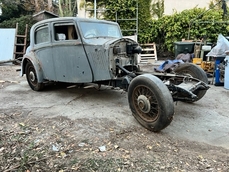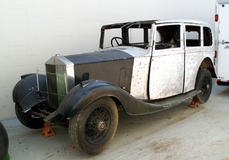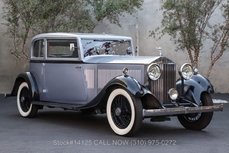Rolls-Royce 20/25 hp Shooting Brake 1930
Allgemeine Beschreibung :
Rolls-Royce’s 20/25 succeeded the 20 HP in 1929 as the company’s small-displacement offering positioned below the flagship Phantom models. Engineers developed a host of improvements over the outgoing 20 HP, and while this was considered an “entry model” for Rolls-Royce, it was still an exclusive, high-end automobile for a discerning clientele. The overhead-valve inline six-cylinder engine displaced 3,669 cc and featured an aluminum crankcase, cast iron cylinder block, and pressurized lubrication. It had both coil and magneto ignition systems, and the four-speed manual gearbox had a traditional right-hand gear lever position. This feature was in response to criticism from customers who complained that the central-mounted 3-speed shifter in the 20 HP models appeared cheap and thus not to the standard expected of a Rolls-Royce. The chassis of the 20/25 was a traditionally robust affair, with a solid front axle, live rear axle, semi-elliptic springs and four-wheel brakes assisted by a mechanical servo.
All of the improvements afforded the new Rolls-Royce 20/25 HP with upwards of 75 mph performance, depending upon the coachwork selected by the owner. Traditionally, Rolls-Royce sold the 20/25 as a complete chassis, less body, and customers specified their preferred coachbuilder at the time of ordering. As a result, a wide variety of 20/25s were built, ranging from formal, closed limousines to more sporting open roadsters. It was not out of the ordinary for a 20/25 to receive more than one body in its lifetime, as individual owner’s tastes evolved, and the robust chassis could easily outlive its original coachwork. It proved to be quite popular, and nearly 4,000 were built between 1929 and 1936, making the 20/25 one of the most successful Rolls-Royce models of the period.
Our featured 20/25 is a marvelous example of this versatile Rolls-Royce model and with a rich and fascinating history from new. GSR4 is a long-chassis model initially purchased in 1929 by coachbuilders Rippon Brothers, Ltd of Yorkshire, for use as a company demonstrator. Rippon was among the oldest names in the British coachbuilding business – Walter Rippon built coaches for the Earl of Rutland in 1555, and for Elizabeth I in 1564. By the 1930s, they already had a long history with Rolls-Royce. The company built its first motorcar body in 1905 atop a Rolls-Royce chassis. Rippon Bros. used GSR4 to showcase a limousine body, which was subsequently sold to Mr. Frank Broadhead, Esq. of Almondbury, Yorkshire, in May 1930. Mr. Broadhead was managing director of Kirkheaton Mills, a large wool textile mill. The car lived a relatively unassuming life at first, being chauffeur-driven exclusively by Mr. Sam Belton and used to shuttle Mr. Broadhead to work, and on company business. Its most notable passenger at the time was the future King George VI, then the Duke of York, who rode in the car during an official state visit to the mill on March 11, 1932.
Around 1939, as World War II erupted across Europe, the patriotic Mr. Broadhead enlisted his faithful Rolls-Royce to assist the war effort. The military unceremoniously scrapped the rear limousine section of the body and replaced it with a purposeful, albeit inelegant, ambulance body. Chassis GSR4 was put into service transporting sick and wounded soldiers from the local train station to the hospital, reportedly performing its critical duties without fault.
After the war, the car returned to the possession of Broadhead and the Kirkheaton Mill. The ambulance body was removed, and in its place, a more suitable shooting brake body was fitted. Credit for the coachwork goes to S. Pexton & Son, or more specifically, Harold Pexton, who directed woodworker Reuben Metcalf and blacksmith Leslie Walshaw to frame and skin the body. It then returned to service at the mill as a high-end delivery vehicle, transporting wool goods to clients and guests to picnics in the countryside. A promotional postcard in the history file shows GSR4 leaving the gates at Buckingham Palace, presumably after a delivery. All along, the loyal company chauffeur Sam Belton remained at the helm. So meticulous was Belton in his care for the Rolls that it turned a half-million miles while serving as the mill’s delivery vehicle.
In the 1960s, Mr. Roger LaViale purchased GSR4 and brought it to the USA via Cunard Lines “RMS Scythia.” LaViale was also in the textile business, and he used the Rolls-Royce as a promotional tool to spread the word about quality English wool, going so far as to hire Belton to drive the car to various high-end department stores around the US. With the tour completed, he sold the car to Mr. Waterman of Nashville, TN, in 1967. In 1972, Dr. Sessions of Marietta, Georgia acquired it. Dr. Sessions had been aware of the car for a few years and was fascinated by its unique coachwork. He became a passionate custodian of GSR4 for nearly five decades and spent many years tracing the car’s history, going so far as to travel to Yorkshire to interview former mill employees who recalled the Rolls when it was in service.
In 1973 a leaky radiator took the car off the road, which led to a 30-year restoration project (as these things sometimes do). Finally, in 2003, the restoration was declared “complete,” and the Sessions family proudly showed GSR4 at numerous RROC concours events and gatherings. It debuted at the RROC Newport meet in 2003, scoring an impressive 387 of 400 points.
Today, it presents in excellent condition throughout, thanks to the meticulous restoration and care. In place of the previous single-tone maroon color is this attractive maroon and cream livery, which suits the coachwork marvelously. Despite the obscurity of the coachbuilder, the quality is superb, with plenty of intriguing details, accentuated by the high-quality restoration. The interior woodwork is beautiful, and the spacious rear compartment includes a pair of clever side-facing jump seats that fold into the floor, and integrated wood cabinets complete with picnic china. The front compartment upholstery is preserved, except for only the driver’s seat squab, which has been reupholstered. Switches and controls are correct, as are the original instruments.
Incredibly, after more than 500,000 miles, GSR4 still retains its original engine per the factory build sheets. It runs beautifully, and the car feels impressively tight on the road, making this Rolls-Royce is an excellent choice for touring, RROC gatherings, or simply for picnics in the countryside. This beautiful, one-off shooting brake has a truly fascinating story, and it is ready for a new caretaker to add the next chapter.
Offers welcome and trades considered
https://hymanltd.com/vehicles/6585
1930 Rolls-Royce 20/25 hp Shooting Brake is listed verkauft on ClassicDigest in St. Louis by Mark Hyman for $79500.
Fakten der Auto
Karosserietyp : Auto Marke : Rolls-Royce Modell : 20/25 Ausführung : hp Shooting Brake Hubraum : 0.0 Modelljahr : 1930 Karosstyp : Kombi Lage : Missouri
Verkauft
Angaben Zum Verkäufer
Verkauft
People who viewed this Rolls-Royce 20/25 also viewed similar Rolls-Royce listed at ClassicDigest
Other cars listed for sale by this dealer
über Rolls-Royce
Nun, meine Damen und Herren, heute tauchen wir ein in die glanzvolle Geschichte einer Marke, die immer das ganz Wesen britischen Luxus und Handwerkskunst verkörpert hat - Rolls-Royce.Unsere Geschichte beginnt zu Beginn des 20. Jahrhunderts, als zwei Visionäre, Charles Rolls und Henry Royce, beschlossen, sich zusammenzuschließen. Im Jahr 1904 wurde der allererste Rolls-Royce geboren, der Rolls-Royce 10 hp. Es war ein bescheidener Anfang für ein Unternehmen, das die Automobil-Exzellenz neu definieren würde.
Aber es war erst 1907, dass Rolls-Royce wirklich seinen Stempel aufdrückte, mit der Einführung des Silver Ghost. Er wurde als das "Beste Auto der Welt" gefeiert und setzte den Goldstandard für Luxusautos. Mit seinem flüsterleisen Motor und seiner exquisiten Handwerkskunst war er ein Statement von Opulenz und Raffinesse.
Die 1920er Jahre brachten uns den Rolls-Royce Phantom I, ein Ikone seiner Zeit. Es war der erste Rolls-Royce mit einem 6-Zylinder-Motor und legte den Grundstein für die legendäre Phantom-Reihe. Dies war die Ära, in der die Maharadschas von Indien maßgefertigte Rolls-Royces in Auftrag gaben, die nichts weniger als automobilen Palästen entsprachen.
Schnell vorwärts in die Nachkriegsjahre, und wir haben den Silver Cloud, ein Symbol für den britischen Optimismus der Nachkriegszeit. Der Silver Cloud verkörperte Eleganz, mit seinen fließenden Linien und handgefertigten Interieurs. Er war die Wahl von Königen, Prominenten und Industriekapitänen.
Aber wenn wir über das Epizentrum des Rolls-Royce-Luxus sprechen, dann ist es der Rolls-Royce Phantom VI, der uns von 1968 bis 1991 begleitete. Dies war ein Auto, das die Aussage traf, dass "wenn Sie nach dem Preis fragen müssen, können Sie es sich nicht leisten." Anpassung war das Stichwort, und der Phantom VI war eine Leinwand für die weltweit Wohlhabendsten, um ihren einzigartigen Geschmack auszudrücken.
Nun, es ist unmöglich, über Rolls-Royce zu sprechen, ohne den Rolls-Royce Corniche zu erwähnen. Produziert von 1971 bis 1995, handelte es sich um eine Cabriolet- und Coupé-Version des Silver Shadow. Der Corniche war der Inbegriff des Grand Touring, ein Auto für diejenigen, die den Kontinent in absolutem Luxus durchqueren wollten.
Aber, ach, selbst die Mächtigsten müssen ihren Niedergang erleben, und Rolls-Royce war keine Ausnahme. Das Unternehmen durchlief in den 1970er und 80er Jahren finanzielle Turbulenzen, was zur Übernahme durch Vickers plc führte. Dann kam die umstrittene Eigentümerschaft von BMW und Volkswagen, die die Enthusiasten spaltete.
Rolls-Royce erlangte unter BMW-Besitz wieder Boden, und das neue Jahrtausend brachte uns den Rolls-Royce Phantom VII, eine Rückkehr zu den Wurzeln des Unternehmens für kompromisslosen Luxus. Der Phantom VII war ein Zeugnis für britische Ingenieurskunst und Handwerkskunst.
Und das, meine Damen und Herren, bringt uns auf den heutigen Tag. Rolls-Royce produziert weiterhin einige der opulentesten, maßgeschneiderten Fahrzeuge auf dem Planeten, ein Symbol für die britische Imperium, das mit der Zeit nicht verblasst ist. Der Geist von Sir Henry Royce und Charles Rolls lebt in jedem Auto weiter, das die Spirit of Ecstasy trägt, ein Zeugnis für das anhaltende Erbe der britischen Automobil-Exzellenz.











